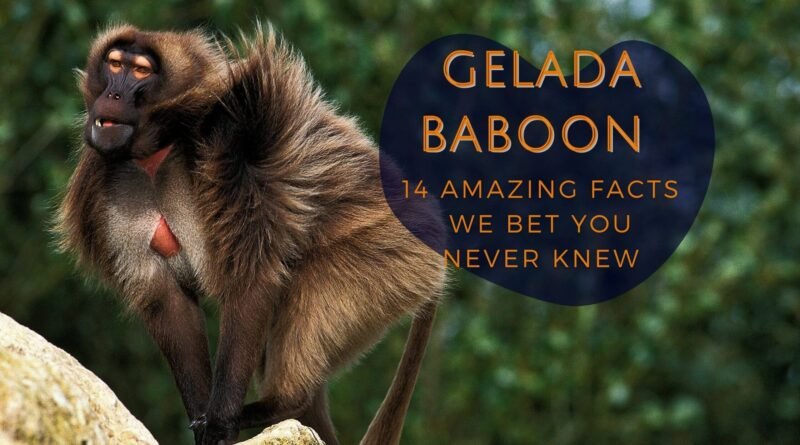14 Amazing facts we bet you never knew about Gelada
Are there such things as talking monkeys? It seems so. They are the Gelada primates, a group of Ethiopian monkeys that have been shown to use a language with striking similarities to that of humans. Not only do they produce a lip sound similar to kissing with the snap of their lips, but they also communicate with a “swinging” rhythm and tone that resemble our own. Let’s find out what are the characteristics of these intelligent monkeys.
- Geladas is a baboon-like primate species and live only in the remote mountains of Ethiopia. The gelada is the last member of the genus Theropithecus, to which the giant baboons belonged. They are entirely terrestrial and feed on grasses and roots of the grasslands. This behavior, very different from that of other arboreal monkeys, is not the only one that resembles primitive humans.

- This species survives in the highest grasslands of Ethiopia, and is known as the bleeding heart monkey, due to the unique coloration of its chest.
- Geladas are medium-sized primates with brown fur that can weigh up to 30 kilos, although they normally weigh between 10 and 20 kilos. Both males and females have a reddish chest, which seems to form a heart. But don’t get it wrong, these are not affectionate animals.
- Geladas spend most of their time finding and eating leaves and grasses, which has resulted in superior development of the opposable thumb. Although it practices preening, like other primates, it is supported by vocalizations in the form of murmurs.
- Unlike most primates, the gelada is exclusively terrestrial. This diurnal primate lives in societies where a leading male has a group of females and a few more males known as followers. However, these central groups are usually supported by groups of 300 individuals.

- These animals have a very special relationship with the Ethiopian wolf. This species is endangered, and the geladas help them hunt, which increases their success. This is because the prey of these carnivorous animals are rodents. The gelada does not seem to gain any advantage from this relationship, which seems to indicate altruism or simple indifference.
- It should be noted that two subspecies of this species have been described, gelada gelada and gelada obscurus, whose fur is darker. This species of African primate shows great sexual differentiation: males have a greater volume of hair, especially on the shoulders, head and cheeks. Their pale eyelids and huge fangs make the threatening gestures of these animals frightening.
- They have a non-prehensile tail, only present in American primates such as the capuchin monkey.
- The species has a life expectancy of 14 years, a reproductive cycle of just over one month and a gestation of six months.
- The rhythm of its babbling corresponds, as with speech, to the opening and closing of the mouth. The pattern of sound made is thus structurally similar to that of human speech. According to Bergman, this behavior has the same function as speech in the most basic human interactions. Geladas can modulate sounds with their lips to emphasize certain sounds over others. Vocalizations make it the only non-human primate that can modulate the volume and pitch of its voice quickly and adaptively, much like humans. It does this through the smacking of its lips.
- Its greatest threat is climate change. Its high habitat maintains suitable temperatures for the species and its food, and rising temperatures mean that the gelada must increase the height of its habitat year after year. The problem is that it can no longer climb higher, and so its habitat is shrinking further. This makes the gelada a true climate refugee.
- Geladas live only in high mountain grasslands, between 1,400 and 4,400 meters above sea level.
- Geladas are a characteristic species of the Ethiopian highlands, differing in several things from this other primate whose name may be more familiar to you. And it’s not just to do with the showy red spots that adorn its chest, which are unique among other primates and have earned it the nickname “bleeding heart monkey.” In females, this region changes color and its edges fill with fluid, indicating that they are ready to mate. In dominant males, the color tends to become even more crimson.

- Their teeth are composed of smaller incisors and larger than normal molars. Their thumbs are longer and stronger than usual, while their index fingers are significantly smaller, which make the geladas a unique species. In fact, they do not share family ancestry with baboons, but are the last of the Theropithecus lineage.
They are the only apes on the planet that feed entirely on plants. While baboons are capable of hunting antelopes, most primates usually include in their diet, at least, insects of various types and also small invertebrate animals, such as lizards or spiders, making them eminently omnivorous species. By not ingesting anything of non-vegetable origin, geladas consume less energy than other monkeys, which has influenced the fact that their brains have not developed a large size.




